Design of Alkali-Activated Materials and Geopolymer for Deep Soilmixing: Interactions with Model Soils
Abstract
:1. Introduction
2. Materials and Methods
2.1. Materials
2.2. Testing Program
2.3. Sample Preparations and Testing Methods
2.3.1. Nuclear Magnetic Resonance
2.3.2. Compressive Strength
2.3.3. Isothermal Calorimetry
3. Results
3.1. Grout Characterization
3.1.1. Long-Term Local Structure
3.1.2. Reaction Advancement
3.1.3. Microstructure and Mechanical Properties
3.2. Effect of H2O/Na2O on Mechanical Properties: Grout Scale
- as the initial volume of reactive solids in the material (precursor and solid fraction of the activation solution).
- as the total water content in the mix.
- as the air volume is considered negligible in the material (confirmed by measurements of initial density).
3.3. Deep Soilmixing Model Materials
3.3.1. Influence of Soil on Reaction Advancement and Local Structure
3.3.2. Effect of Soil Type on Soilmix Strength
4. Conclusions
- The activated slag, activated metakaolin, and binary mixtures showed distinct reaction mechanisms. The presence of calcium, introduced by the slag, significantly influenced the advancement of the reaction and strength development, as observed in 75% metakaolin −25% slag mixtures.
- The analysis of phase composition, chemically bound water, and heat flow profiles highlighted distinctive physicochemical properties of binary metakaolin–slag compared to plain metakaolin or plain slag. These properties resulted from the synergistic interaction between metakaolin and slag.
- The reaction mechanisms affected the water sensitivity of the materials, resulting in Feret’s relation being inadequate to depict strength evolution as a function of initial porosity in the case of binary and metakaolin grouts designed with H2O/Na2O ranging from 21 to 34. Slag-based grouts behaved like hydraulic binders, whereas metakaolin-based grouts showed low bound water content and a relatively high sensitivity of precursor reactivity to H2O/Na2O ratio. Binary mixtures showed the potential to decrease water sensitivity in metakaolin-based grouts. The partial replacement of metakaolin with slag resulted in higher strengths, likely due to reduced porosity (increased bound water) and a potential enhancement in precursor reactivity.
- The composition and properties of soilmix were evaluated with respect to soil type and water content. Water content can be considered as a major parameter influencing the development of mechanical properties. The inclusion of soils in grouts enhanced mechanical properties due to the granular skeleton. The presence of ground silica sand and kaolin did not significantly impact the physico-chemical evolution or reactivity timescale of the system, except for kaolin, which may partially react over the long term.
Author Contributions
Funding
Institutional Review Board Statement
Informed Consent Statement
Data Availability Statement
Acknowledgments
Conflicts of Interest
References
- Bruno, S.; Claude, P.; Laurent, B.; Philippe, L. Amélioration et renforcement des sols—AMSOL—Tome 2. Le Moniteur, 13 June 2018. (In French).
- Meyer, C. The greening of the concrete industry. Cem. Concr. Compos. 2009, 31, 601–605. [Google Scholar] [CrossRef]
- García-Gusano, D.; Herrera, I.; Garraín, D.; Lechón, Y.; Cabal, H. Life cycle assessment of the Spanish cement industry: Implementation of environmental-friendly solutions. Clean Technol. Environ. Policy 2015, 17, 59–73. [Google Scholar] [CrossRef]
- Huntzinger, D.N.; Eatmon, T.D. A life-cycle assessment of Portland cement manufacturing: Comparing the traditional process with alternative technologies. J. Clean. Prod. 2009, 17, 668–675. [Google Scholar] [CrossRef]
- Wang, A.; Zheng, Y.; Zhang, Z.; Liu, K.; Li, Y.; Shi, L.; Sun, D. The Durability of Alkali-Activated Materials in Comparison with Ordinary Portland Cements and Concretes: A Review. Engineering 2020, 6, 695–706. [Google Scholar] [CrossRef]
- Aydın, S.; Baradan, B. Sulfate resistance of alkali-activated slag and Portland cement based reactive powder concrete. J. Build. Eng. 2021, 43, 103205. [Google Scholar] [CrossRef]
- Coudert, E.; Paris, M.; Deneele, D.; Russo, G.; Tarantino, A. Use of alkali activated high-calcium fly ash binder for kaolin clay soil stabilisation: Physicochemical evolution. Constr. Build. Mater. 2019, 201, 539–552. [Google Scholar] [CrossRef]
- Arulrajah, A.; Yaghoubi, M.; Disfani, M.M.; Horpibulsuk, S.; Bo, M.W.; Leong, M. Evaluation of fly ash- and slag-based geopolymers for the improvement of a soft marine clay by deep soil mixing. Soils Found. 2018, 58, 1358–1370. [Google Scholar] [CrossRef]
- Latifi, N.; Meehan, C.L.; Majid, M.A.; Horpibulsuk, S. Strengthening montmorillonitic and kaolinitic clays using a calcium-based non-traditional additive: A micro-level study. Appl. Clay Sci. 2016, 132–133, 182–193. [Google Scholar] [CrossRef]
- Yaghoubi, M.; Arulrajah, A.; Disfani, M.M.; Horpibulsuk, S.; Darmawan, S.; Wang, J. Impact of field conditions on the strength development of a geopolymer stabilized marine clay. Appl. Clay Sci. 2019, 167, 33–42. [Google Scholar] [CrossRef]
- Cristelo, N.; Glendinning, S.; Miranda, T.; Oliveira, D.; Silva, R. Soil stabilisation using alkaline activation of fly ash for self compacting rammed earth construction. Constr. Build. Mater. 2012, 36, 727–735. [Google Scholar] [CrossRef]
- Cristelo, N.; Glendinning, S.; Fernandes, L.; Pinto, A.T. Effect of calcium content on soil stabilisation with alkaline activation. Constr. Build. Mater. 2012, 29, 167–174. [Google Scholar] [CrossRef]
- Zhang, M.; Guo, H.; El-Korchi, T.; Zhang, G.; Tao, M. Experimental feasibility study of geopolymer as the next-generation soil stabilizer. Constr. Build. Mater. 2013, 47, 1468–1478. [Google Scholar] [CrossRef]
- Zhang, M.; Zhao, M.; Zhang, G.; Nowak, P.; Coen, A.; Tao, M. Calcium-free geopolymer as a stabilizer for sulfate-rich soils. Appl. Clay Sci. 2015, 108, 199–207. [Google Scholar] [CrossRef]
- Cassagnabère, F.; Diederich, P.; Mouret, M.; Escadeillas, G.; Lachemi, M. Impact of metakaolin characteristics on the rheological properties of mortar in the fresh state. Cem. Concr. Compos. 2013, 37, 95–107. [Google Scholar] [CrossRef]
- Provis, J. Alkali Activated Materials: State-of-the-Art Report, RILEM TC 224-AAM; Springer Science & Business Media: New York, NY, USA, 2013; Volume 13, ISBN 978-94-007-7671-5. [Google Scholar]
- Turner, L.K.; Collins, F.G. Carbon dioxide equivalent (CO2-e) emissions: A comparison between geopolymer and OPC cement concrete. Constr. Build. Mater. 2013, 43, 125–130. [Google Scholar] [CrossRef]
- Cherki El Idrissi, A.; Rozière, E.; Darson-Balleur, S.; Loukili, A. Resistance of alkali-activated grouts to acid leaching. Constr. Build. Mater. 2019, 228, 116681. [Google Scholar] [CrossRef]
- Rios, S.; Ramos, C.; Viana da Fonseca, A.; Cruz, N.; Rodrigues, C. Mechanical and durability properties of a soil stabilised with an alkali-activated cement. Eur. J. Environ. Civ. Eng. 2019, 23, 245–267. [Google Scholar] [CrossRef]
- Singh, N.B.; Middendorf, B. Geopolymers as an alternative to Portland cement: An overview. Constr. Build. Mater. 2020, 237, 117455. [Google Scholar] [CrossRef]
- Aboulayt, A.; Jaafri, R.; Samouh, H.; Cherki El Idrissi, A.; Roziere, E.; Moussa, R.; Loukili, A. Stability of a new geopolymer grout: Rheological and mechanical performances of metakaolin-fly ash binary mixtures. Constr. Build. Mater. 2018, 181, 420–436. [Google Scholar] [CrossRef]
- Azadi, M.R.; Taghichian, A.; Taheri, A. Optimization of cement-based grouts using chemical additives. J. Rock Mech. Geotech. Eng. 2017, 9, 623–637. [Google Scholar] [CrossRef]
- Güllü, H.; Cevik, A.; Al-Ezzi, K.M.A.; Gülsan, M.E. On the rheology of using geopolymer for grouting: A comparative study with cement-based grout included fly ash and cold bonded fly ash. Constr. Build. Mater. 2019, 196, 594–610. [Google Scholar] [CrossRef]
- Yahya, Z.; Abdullah, M.; Hussin, K.; Ismail, K.; Razak, R.; Sandu, A. Effect of Solids-To-Liquids, Na2SiO3-To-NaOH and Curing Temperature on the Palm Oil Boiler Ash (Si + Ca) Geopolymerisation System. Materials 2015, 8, 2227–2242. [Google Scholar] [CrossRef]
- Al-Duais, I.N.A.; Ahmad, S.; Al-Osta, M.M.; Maslehuddin, M.; Saleh, T.A.; Al-Dulaijan, S.U. Optimization of alkali-activated binders using natural minerals and industrial waste materials as precursor materials. J. Build. Eng. 2023, 69, 106230. [Google Scholar] [CrossRef]
- Pouhet, R.; Cyr, M.; Bucher, R. Influence of the initial water content in flash calcined metakaolin-based geopolymer. Constr. Build. Mater. 2019, 201, 421–429. [Google Scholar] [CrossRef]
- Cherki El Idrissi, A.; Roziere, E.; Loukili, A.; Darson, S. Design of geopolymer grouts: The effects of water content and mineral precursor. Eur. J. Environ. Civ. Eng. 2018, 22, 628–649. [Google Scholar] [CrossRef]
- Souayfan, F.; Roziere, E.; Justino, C.; Paris, M.; Deneele, D.; Loukili, A. Comprehensive study on the reactivity and mechanical properties of alkali-activated metakaolin at high H2O/Na2O ratios. Appl. Clay Sci. 2023, 231, 106758. [Google Scholar] [CrossRef]
- Samson, G.; Cyr, M.; Gao, X.X. Formulation and characterization of blended alkali-activated materials based on flash-calcined metakaolin, fly ash and GGBS. Constr. Build. Mater. 2017, 144, 50–64. [Google Scholar] [CrossRef]
- Burciaga-Díaz, O.; Magallanes-Rivera, R.X.; Escalante-García, J.I. Alkali-activated slag-metakaolin pastes: Strength, structural, and microstructural characterization. J. Sustain. Cem. Based Mater. 2013, 2, 111–127. [Google Scholar] [CrossRef]
- Bernal, S.A. Effect of the activator dose on the compressive strength and accelerated carbonation resistance of alkali silicate-activated slag/metakaolin blended materials. Constr. Build. Mater. 2015, 98, 217–226. [Google Scholar] [CrossRef]
- Souayfan, F.; Rozière, E.; Paris, M.; Deneele, D.; Loukili, A.; Justino, C. 29Si and 27Al MAS NMR spectroscopic studies of activated metakaolin-slag mixtures. Constr. Build. Mater. 2022, 322, 126415. [Google Scholar] [CrossRef]
- Duxson, P.; Fernández-Jiménez, A.; Provis, J.L.; Lukey, G.C.; Palomo, A.; van Deventer, J.S.J. Geopolymer technology: The current state of the art. J. Mater. Sci. 2007, 42, 2917–2933. [Google Scholar] [CrossRef]
- NF EN 12390-3; Testing Hardened Concrete—Part 3: Compressive Strength of Test Specimens. AFNOR: La Plaine Saint-Denis, France, 2019.
- NF EN 12390-1; Testing Hardened Concrete—Part 1: Shape, Dimensions and Other Requirements for Specimens and Moulds. AFNOR: La Plaine Saint-Denis, France, 2012.
- Andersen, M.D.; Jakobsen, H.J.; Skibsted, J. A new aluminium-hydrate species in hydrated Portland cements characterized by 27Al and 29Si MAS NMR spectroscopy. Cem. Concr. Res. 2006, 36, 3–17. [Google Scholar] [CrossRef]
- Cherki El Idrissi, A.; Paris, M.; Rozière, E.; Deneele, D.; Darson, S.; Loukili, A. Alkali-activated grouts with incorporated fly ash: From NMR analysis to mechanical properties. Mater. Today Commun. 2018, 14, 225–232. [Google Scholar] [CrossRef]
- Gao, X.; Yu, Q.L.; Brouwers, H.J.H. Apply 29Si, 27Al MAS NMR and selective dissolution in identifying the reaction degree of alkali activated slag-fly ash composites. Ceram. Int. 2017, 43, 12408–12419. [Google Scholar] [CrossRef]
- Aboulayt, A.; Souayfan, F.; Roziere, E.; Jaafri, R.; Cherki El Idrissi, A.; Moussa, R.; Justino, C.; Loukili, A. Alkali-activated grouts based on slag-fly ash mixtures: From early-age characterization to long-term phase composition. Constr. Build. Mater. 2020, 260, 120510. [Google Scholar] [CrossRef]
- Palomo, A.; Alonso, S.; Fernandez-Jiménez, A.; Sobrados, I.; Sanz, J. Alkaline activation on fly ashes. A Si NMR study of the reaction products. J. Am. Ceram. Soc. 2004, 87, 5. [Google Scholar]
- Garcia-Lodeiro, I.; Palomo, A.; Fernández-Jiménez, A. An overview of the chemistry of alkali-activated cement-based binders. In Handbook of Alkali-Activated Cements, Mortars and Concretes; Elsevier: Amsterdam, The Netherlands, 2015; pp. 19–47. ISBN 978-1-78242-276-1. [Google Scholar]
- Davidovits, J.; Cordi, S.A. Synthesis of New High-Temperature Geo-Polymers for Reinforced Plastics/Composites. In Proceedings of the PACTEC ’79 Society of Plastics Engineers, Costa Mesa, CA, USA, 31 January–2 February 1979; Volume 79, pp. 151–154. [Google Scholar]
- Lee, N.K.; Lee, H.K. Reactivity and reaction products of alkali-activated, fly ash/slag paste. Constr. Build. Mater. 2015, 81, 303–312. [Google Scholar] [CrossRef]
- Richardson, I.G. The calcium silicate hydrates. Cem. Concr. Res. 2008, 38, 137–158. [Google Scholar] [CrossRef]
- Walkley, B.; San Nicolas, R.; Sani, M.-A.; Rees, G.J.; Hanna, J.V.; van Deventer, J.S.J.; Provis, J.L. Phase evolution of C-(N)-A-S-H/N-A-S-H gel blends investigated via alkali-activation of synthetic calcium aluminosilicate precursors. Cem. Concr. Res. 2016, 89, 120–135. [Google Scholar] [CrossRef]
- Myers, R.J.; Bernal, S.A.; San Nicolas, R.; Provis, J.L. Generalized Structural Description of Calcium–Sodium Aluminosilicate Hydrate Gels: The Cross-Linked Substituted Tobermorite Model. Langmuir 2013, 29, 5294–5306. [Google Scholar] [CrossRef]
- Yao, X.; Zhang, Z.; Zhu, H.; Chen, Y. Geopolymerization process of alkali–metakaolinite characterized by isothermal calorimetry. Thermochim. Acta 2009, 493, 49–54. [Google Scholar] [CrossRef]
- Buchwald, A.; Hilbig, H.; Kaps, C. Alkali-activated metakaolin-slag blends—Performance and structure in dependence of their composition. J. Mater. Sci. 2007, 42, 3024–3032. [Google Scholar] [CrossRef]
- Chen, X.; Sutrisno, A.; Struble, L.J. Effects of calcium on setting mechanism of metakaolin-based geopolymer. J. Am. Ceram. Soc. 2017, 101, 957–968. [Google Scholar] [CrossRef]
- Chen, X.; Kim, E.; Suraneni, P.; Struble, L. Quantitative Correlation between the Degree of Reaction and Compressive Strength of Metakaolin-Based Geopolymers. Materials 2020, 13, 5784. [Google Scholar] [CrossRef] [PubMed]
- Puligilla, S.; Mondal, P. Role of slag in microstructural development and hardening of fly ash-slag geopolymer. Cem. Concr. Res. 2013, 43, 70–80. [Google Scholar] [CrossRef]
- Chen, X.; Sutrisno, A.; Zhu, L.; Struble, L.J. Setting and nanostructural evolution of metakaolin geopolymer. J. Am. Ceram. Soc. 2017, 100, 2285–2295. [Google Scholar] [CrossRef]
- Souayfan, F.; Rozière, E.; Loukili, A.; Justino, C. Effect of Retarders on the Reactivity and Hardening Rate of Alkali-Activated Blast Furnace Slag Grouts. Materials 2023, 16, 5824. [Google Scholar] [CrossRef] [PubMed]
- Fernandez-Jimenez, A.; García-Lodeiro, I.; Palomo, A. Durability of alkali-activated fly ash cementitious materials. J. Mater. Sci. 2007, 42, 3055–3065. [Google Scholar] [CrossRef]
- Vitale, E.; Deneele, D.; Paris, M.; Russo, G. Multi-scale analysis and time evolution of pozzolanic activity of lime treated clays. Appl. Clay Sci. 2017, 141, 36–45. [Google Scholar] [CrossRef]
- Abdullahi Effect of aggregate type on Compressive strength of concrete. Int. J. Civ. Struct. Eng. 2012, 2, 791–800. [CrossRef]
- NF EN 14679; Exécution de Travaux Géotechniques Spéciaux Colonnes de Sol Traité. AFNOR: La Plaine Saint-Denis, France, 2005.
- Güllü, H.; Al Nuaimi, M.M.D.; Aytek, A. Rheological and strength performances of cold-bonded geopolymer made from limestone dust and bottom ash for grouting and deep mixing. Bull. Eng. Geol. Environ. 2020, 80, 1103–1123. [Google Scholar] [CrossRef]
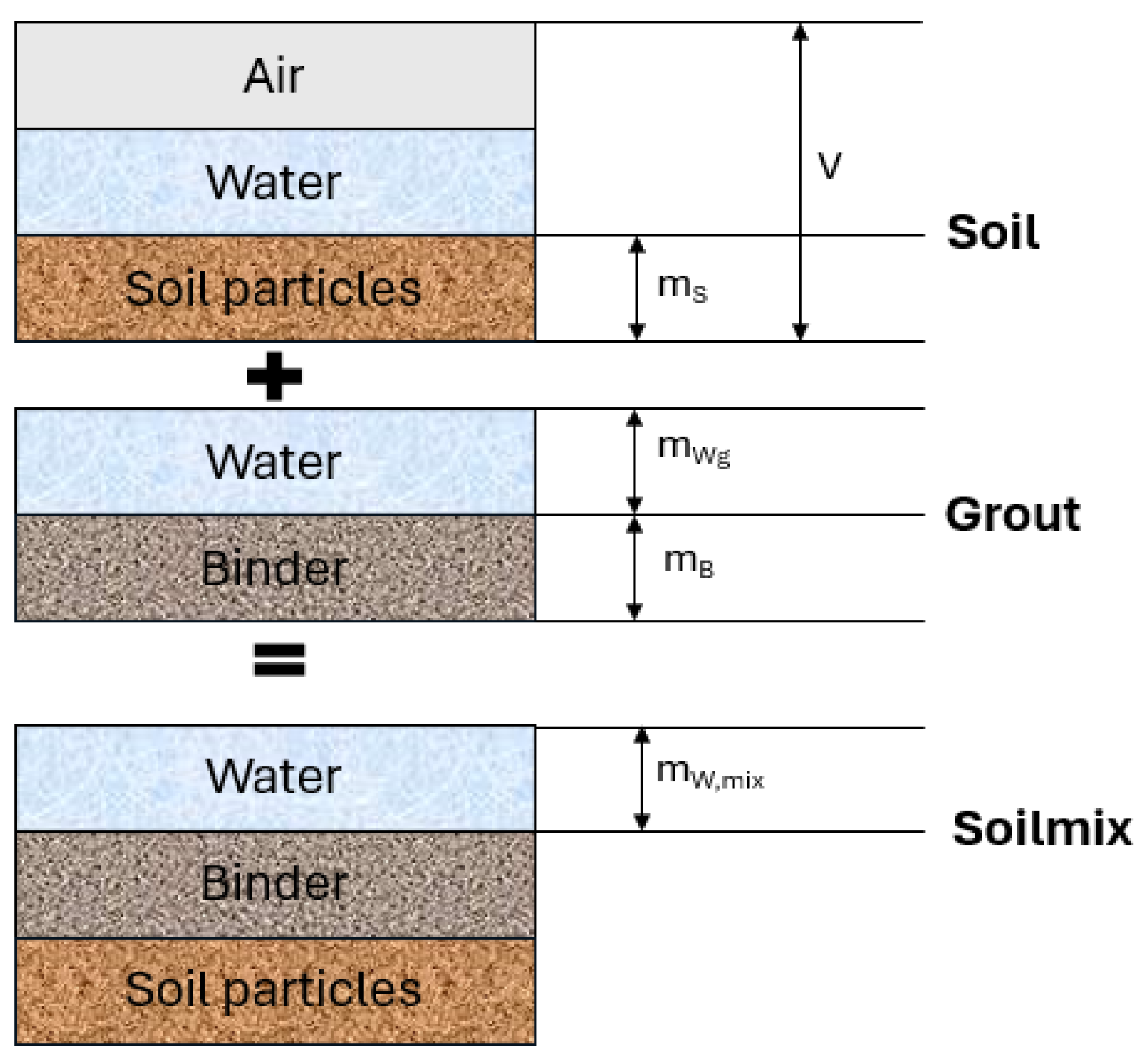
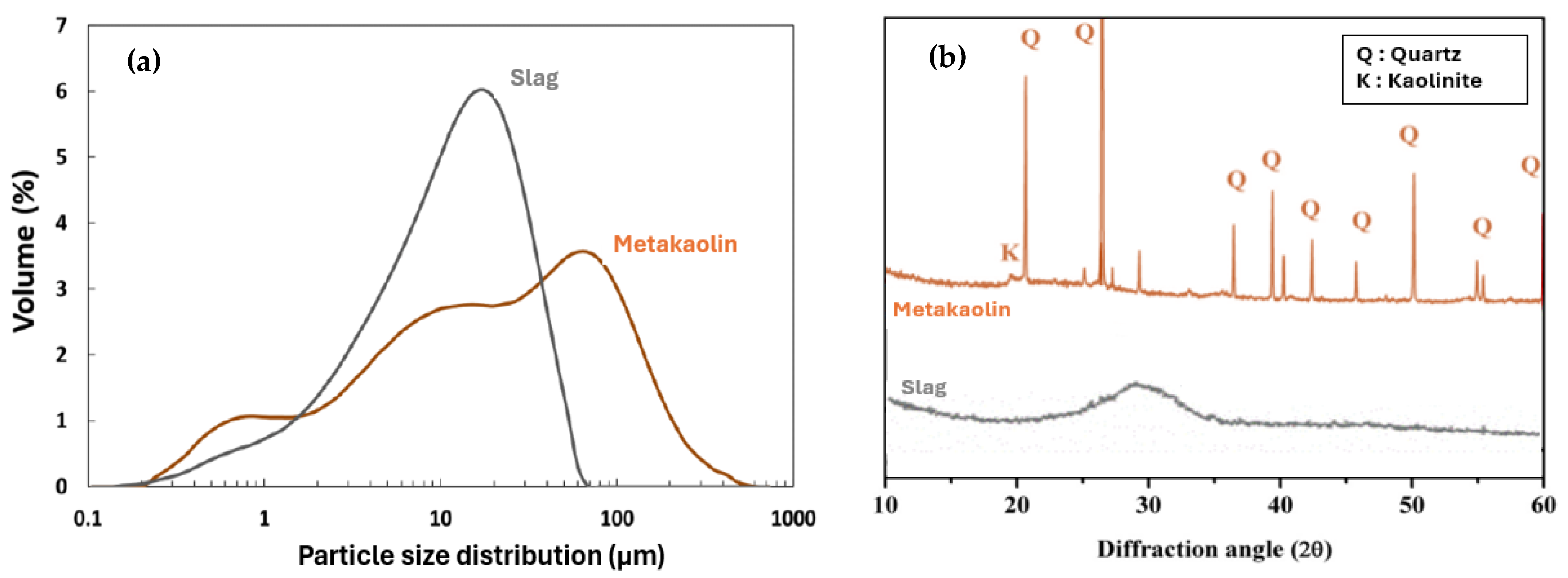
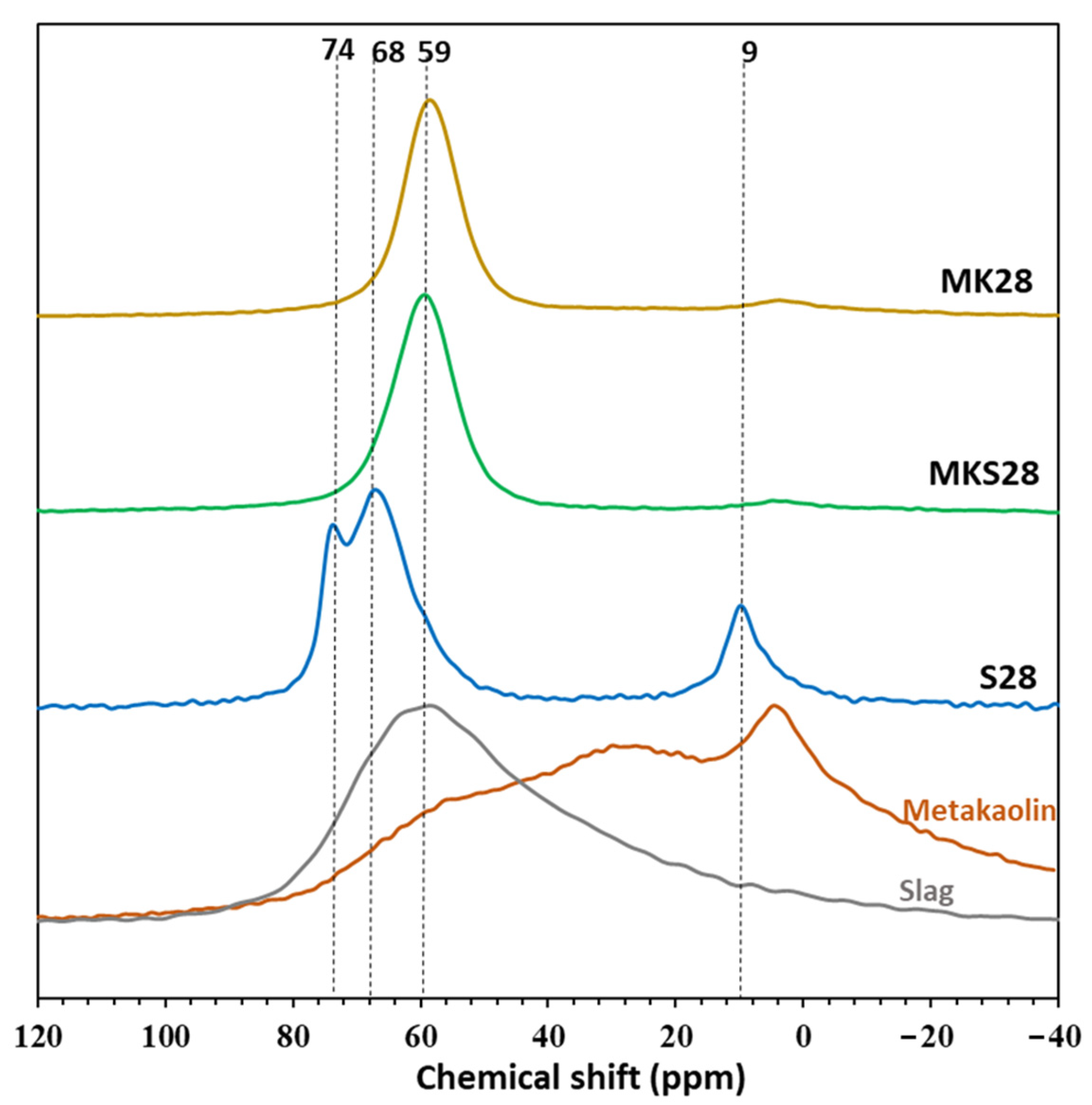
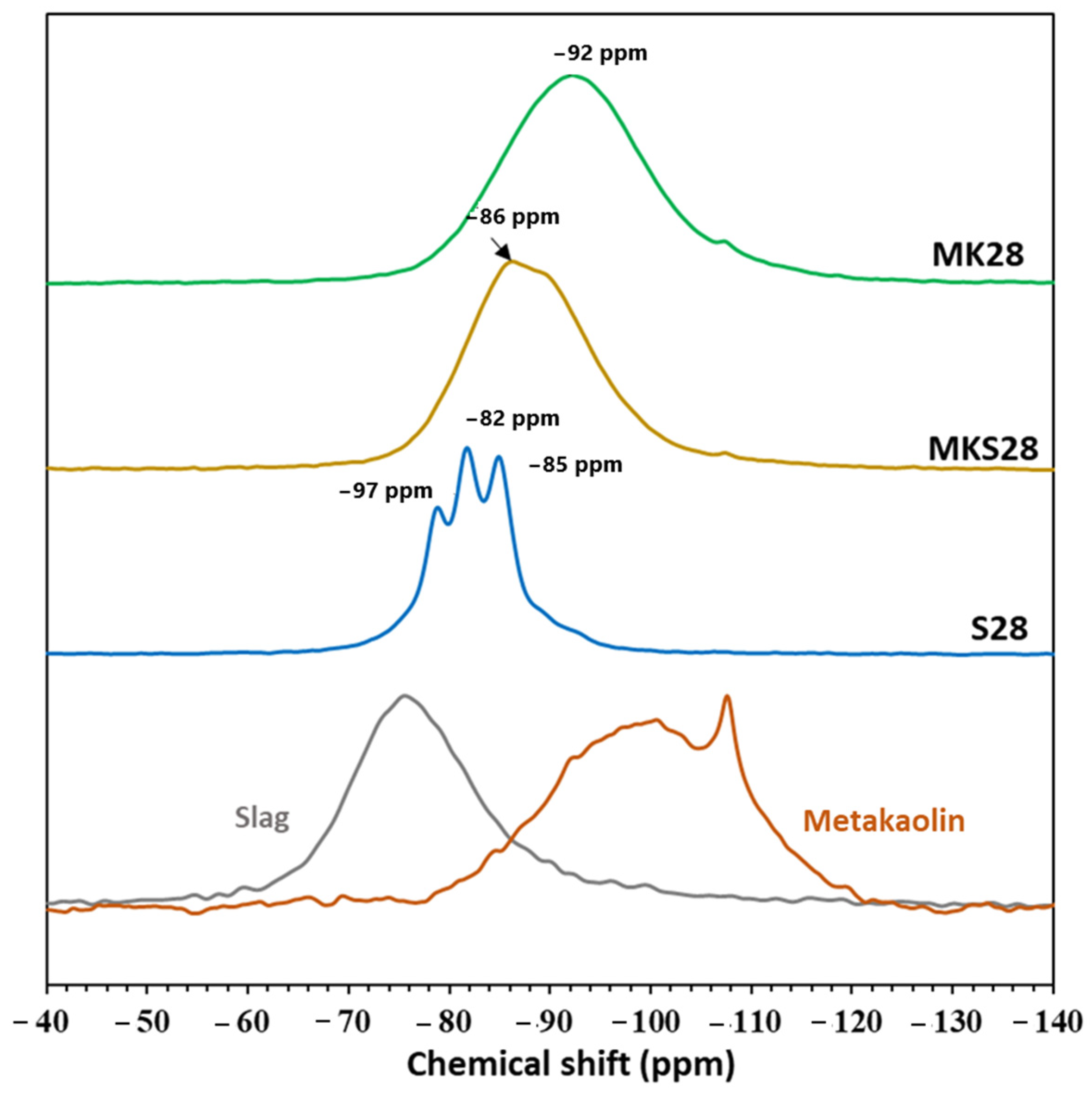

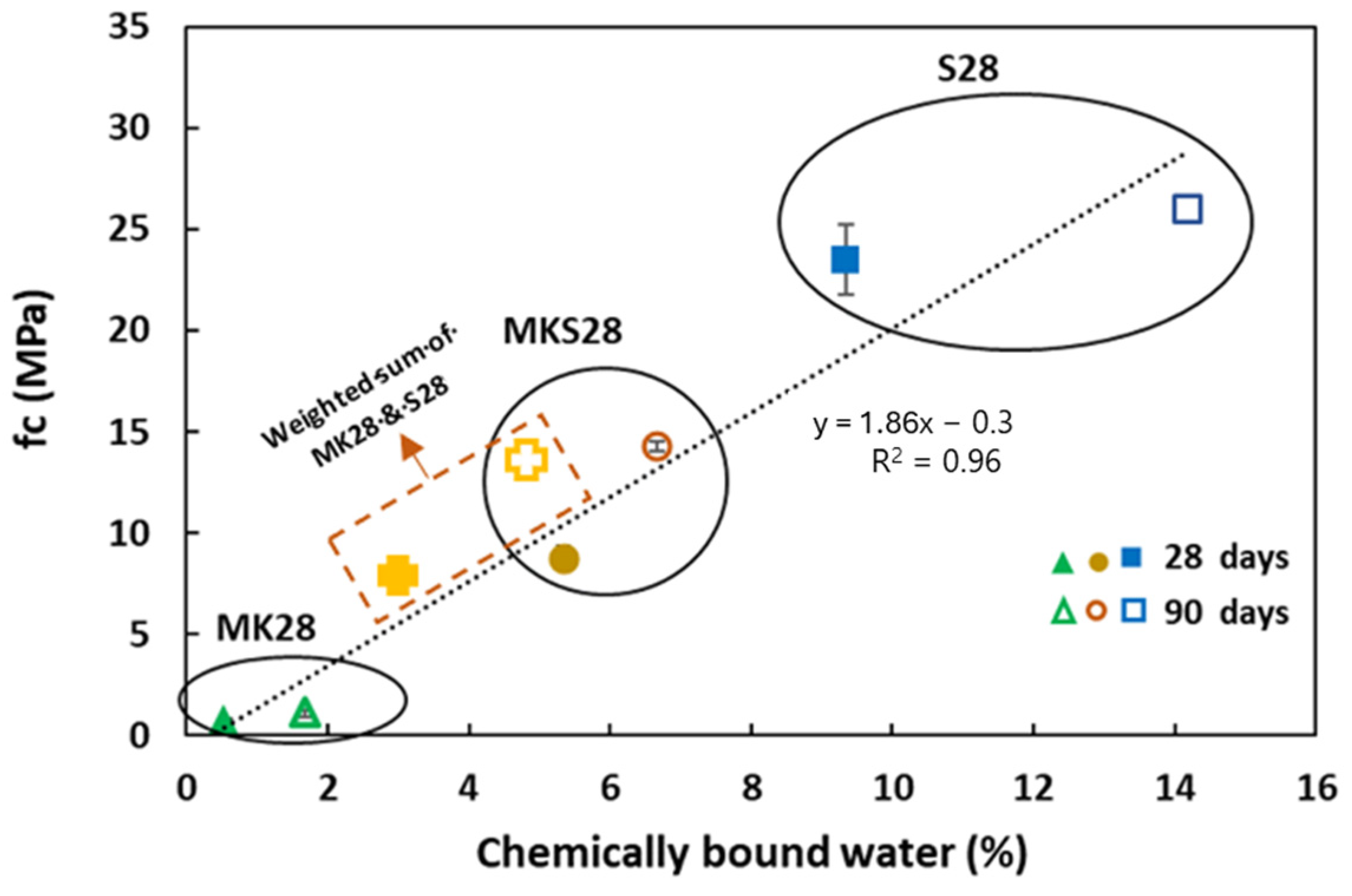


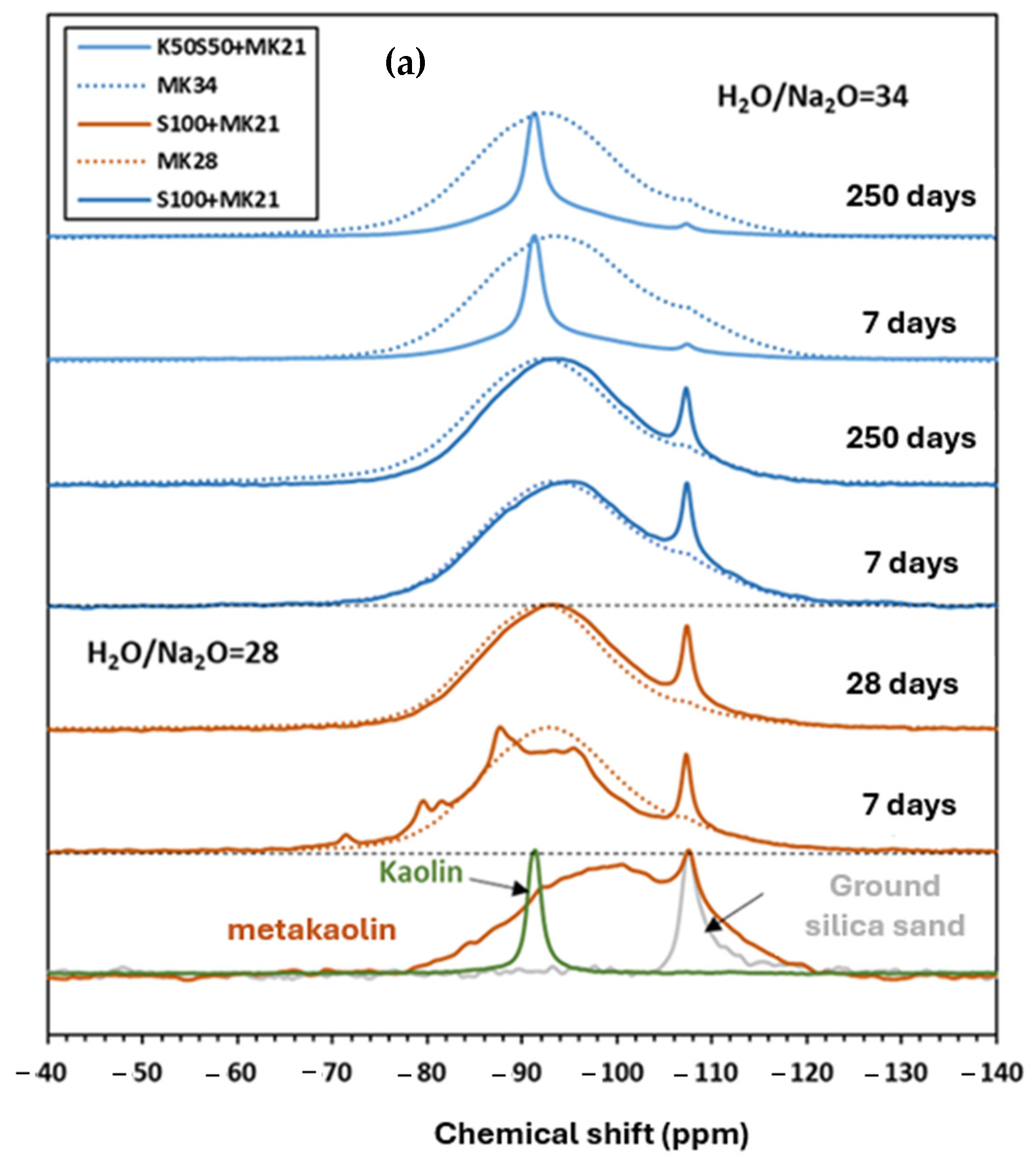


| Composition (wt.%) | Metakaolin | Slag |
|---|---|---|
| SiO2 | 67.1 | 37.2 |
| Al2O3 | 26.8 | 10.5 |
| CaO | 1.12 | 43.2 |
| Fe2O3 | 2.56 | 0.6 |
| MgO | 0.11 | 7.0 |
| SO3 | - | 0.1 |
| Cl− | - | 0.01 |
| TiO2 | 1.3 | 0.5 |
| Na2O | 0.01 | 0.6 |
| Median diameter d50 (µm) | 18 | 10 |
| Specific surface BET (m2.g−1) | 16.5 | 0.45 |
| Density | 2.63 | 2.90 |
| Mixtures | MK28 | S28 | MKS28 | ||
|---|---|---|---|---|---|
| Materials | Density | Compositions (g/L) | |||
| Dry materials | Metakaolin | 2.63 | 604 | - | 464 |
| Slag | 2.9 | - | 666 | 155 | |
| Bentonite | 2.5 | 13 | 13 | 13 | |
| Solution | Na-silicate | 1.55 | 525 | 525 | 525 |
| NaOH pellets | 1.46 | 2.7 | 2.7 | 2.7 | |
| Water | 1 | 429 | 429 | 429 | |
| Water to solid ratio (W/S wt.%) | 0.85 | 0.79 | 0.84 | ||
| Atomic ratio | Si/Al | 1.83 | 4.76 | 2.2 | |
| Na/Al | 1 | 2.1 | 1.1 | ||
| Molar ratio | H2O/Na2O | 28 | 28 | 28 | |
| Materials | Dry Materials | Solution | Water to Solid Ratio W/S (wt.%) | H2O/Na2O | |||||
|---|---|---|---|---|---|---|---|---|---|
| Composition(g/L) | Metakaolin | Slag | Bentonite | Na-Silicate | NaOH | Water | |||
| Metakaolin-based grouts | MK21 | 732 | - | 9 | 636 | 3.3 | 310 | 0.65 | 21 |
| MK24 | 671 | - | 11 | 583 | 3 | 367 | 0.75 | 24 | |
| MK28 | 604 | - | 13 | 525 | 2.7 | 429 | 0.85 | 28 | |
| MK34 | 518 | - | 15 | 450 | 2.3 | 511 | 1 | 34 | |
| Slag-based grouts | S38 | - | 861 | 14 | 348 | 3.5 | 476 | 0.65 | 38 |
| S44 | - | 780 | 16 | 315 | 3.2 | 526 | 0.75 | 44 | |
| S50 | - | 711 | 17 | 288 | 2.9 | 567 | 0.85 | 50 | |
| S62 | - | 608 | 19 | 246 | 2.5 | 623 | 1 | 62 | |
| Binary metakaolin–slag mixtures (75/25 wt.%) | MKS21 | 562 | 187 | 9 | 636 | 3.3 | 310 | 0.64 | 21 |
| MKS24 | 515 | 172 | 11 | 583 | 3 | 367 | 0.73 | 24 | |
| MKS28 | 464 | 155 | 13 | 525 | 2.7 | 429 | 0.84 | 28 | |
| MKS34 | 397 | 133 | 15 | 450 | 2.3 | 511 | 1 | 34 | |
| Materials | Dry Materials | Solution | Water to Solid Ratio W/S (wt.%) | H2O/Na2O | |||||
|---|---|---|---|---|---|---|---|---|---|
| Composition g | Metakaolin | Slag | Bentonite | Na-Silicate | NaOH | Water | |||
| Metakaolin-based grouts (1 L) | MK21 | 732 | - | 9 | 636 | 3.3 | 310 | 0.65 | 21 |
| Model soil (1 L) | Ground silica sand | Kaolin | Water | Ratios of soil mixtures | |||||
| S100 | 2102 | - | 207 | 0.85 | 28 | ||||
| S100 | 1618 | - | 390 | 1 | 34 | ||||
| S50K50 | 749 | 749 | 390 | 1 | 34 | ||||
Disclaimer/Publisher’s Note: The statements, opinions and data contained in all publications are solely those of the individual author(s) and contributor(s) and not of MDPI and/or the editor(s). MDPI and/or the editor(s) disclaim responsibility for any injury to people or property resulting from any ideas, methods, instructions or products referred to in the content. |
© 2024 by the authors. Licensee MDPI, Basel, Switzerland. This article is an open access article distributed under the terms and conditions of the Creative Commons Attribution (CC BY) license (https://creativecommons.org/licenses/by/4.0/).
Share and Cite
Souayfan, F.; Roziere, E.; Paris, M.; Deneele, D.; Loukili, A.; Justino, C. Design of Alkali-Activated Materials and Geopolymer for Deep Soilmixing: Interactions with Model Soils. Materials 2024, 17, 3783. https://doi.org/10.3390/ma17153783
Souayfan F, Roziere E, Paris M, Deneele D, Loukili A, Justino C. Design of Alkali-Activated Materials and Geopolymer for Deep Soilmixing: Interactions with Model Soils. Materials. 2024; 17(15):3783. https://doi.org/10.3390/ma17153783
Chicago/Turabian StyleSouayfan, Faten, Emmanuel Roziere, Michael Paris, Dimitri Deneele, Ahmed Loukili, and Christophe Justino. 2024. "Design of Alkali-Activated Materials and Geopolymer for Deep Soilmixing: Interactions with Model Soils" Materials 17, no. 15: 3783. https://doi.org/10.3390/ma17153783





